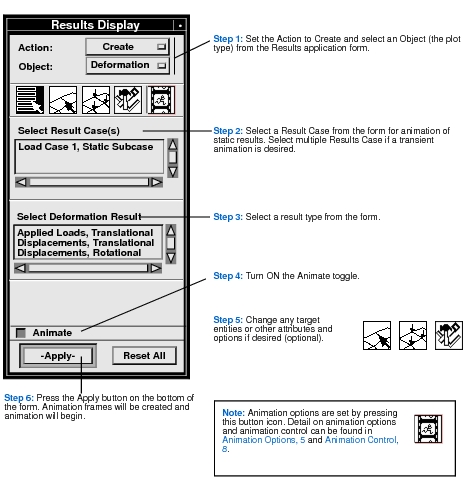XXXXXXXXXXXXXXXXXXXXXXXXXXXXXXXXXXXXXXXXXXXXXXXXXXXXXXXXXXXXXXXXXXXXXXXXXXXXXXXXXXXXXXXXXXXXXXXXXXXXXXXXXXXXXXXXXXXXXXXXXXXXXXXXXXXXXXXXXXXXXXXXXXXXXXXX''"> 9.1 Overview
Result animations are an integral part of understanding the behavior of a structure, especially those subjected to dynamic forces. Animations in Patran are set up in a variety of ways. Most plots, once created, can be animated. Or they can be animated at creation time. To successfully create an animation it is important to first understand how to create a plot. For an overview of how the Results Application works please see
Introduction to Results Postprocessing, 1.
To specifically create an animation of a given plot type at creation time, simply turn ON the Animate button with the Object set to the desired plot type. The general steps to take when creating an animation at plot creation time are
:
There are two aspects of animation: setting up the animation and controlling the animation once the animation frames have been created. For most basic animations, the default settings will be appropriate. However full control is given to the user to change animation options.
Animation options for any given plot type is controlled from the Animation Options form which is accessible by pressing the right most button icon on the Results Application form when the Object is set to a plot type. These options control things such as the number of frames to be generated, the animation method (modal, ramped, global variable), starting and ending values, 2D or 3D animation and interpolation methods. All settings are saved with a plot when it is created whether animation has been enabled or not. An explanation of these settings is given in
Animation Options, 5.

Once an animation is in progress or the frames are being created, a form appears to control the animation. Control is given over such things as stopping and starting, pausing, stepping, speeding up and slowing down the animation. More detailed explanation of animation control is given in
Animation Control, 8.
It is possible to save any result plots to the database with a specific name. In fact all plots are saved to the database with default names if none is given. Any plot that has already been created and saved to the database can be animated even though it was not animated when it was created. All attributes of that plot have been saved such as the result or results associated with it, its display properties, target display entities, and other options. Any animation attributes given to a plot is only active as long as the plot is posted. They are not saved in the database. Animation of existing plots is done by setting the object in the Results application to Animation and then selecting the plots to animate and those to remain static. This is explained in detail in the next section.

